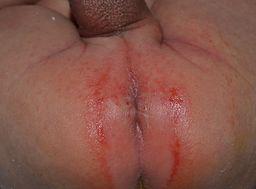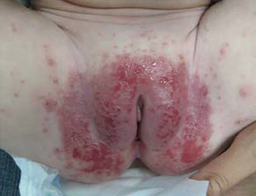Nappy rash
Peer reviewed by Dr Philippa Vincent, MRCGPLast updated by Dr Rachel Hudson, MRCGPLast updated 16 May 2023
Meets Patient’s editorial guidelines
- DownloadDownload
- Share
- Language
- Discussion
Most babies develop a nappy rash at some stage. Usually it is mild and does not bother your baby. However, it can be more severe and sore in some cases. It can usually be managed with the suggestions below.
In this article:
Continue reading below
What causes nappy rash?
Nappy rash is a skin inflammation. Most cases are due to a reaction of the skin to urine and poo. Babies have sensitive skin which is vulnerable to irritation.
Nappy rash

By Dailyboth, CC0, via Wikimedia Commons
In addition, a germ called candida commonly thrives on the inflamed skin. (This is the germ that also causes the infection commonly known as thrush which most often occurs in the mouth (oral thrush) or around the genital area.) Candida can cause a more inflamed rash which is a brighter or darker red. Sometimes the rash can also become infected with other types of germs called bacteria. This will also make the rash more red and sore.
Nappy rash candida

By Elaine C. Siegfried1,†* and Adelaide A. Hebert2,†, CC BY 4.0, via Wikimedia Commons
Nappy rash can occur or worsen when your baby is teething. It is unclear why teething can lead to nappy rash although it is thought that it is due to your baby producing more saliva. This changes the nature of the baby's poo, making it more likely to cause a reaction when it touches the skin.
Most nappy rashes are mild or moderate and are not serious. Occasionally, skin conditions such as eczema, psoriasis, infections and some rare skin diseases cause unusual nappy rashes.
How can I heal or prevent nappy rash?
Leave the nappy off as much as possible
This allows fresh air to get to the skin. Obviously, you cannot leave the nappy off all the time. However, the more fresh air, the better. Try letting the baby lie without a nappy on a towel or disposable absorbent sheet for a period of time each day. However, do change the towel or sheet as soon as it becomes wet.
Change the nappy often
Ideally, change the nappy as soon as it is wet or soiled. The aim is to prevent your baby's skin being in contact with urine and poo (faeces) for long periods of time. This is especially important if your baby is teething and has offensive, runny poo.
Wipes are as effective as water
Studies have shown that using baby wipes has the same effect on your baby's skin as using cotton wool and water. However, it is best to use wipes which are free from fragrance or alcohol.
After washing, make sure the baby's bottom is properly dry
Do this before putting on a new nappy. Dry by patting, not by rubbing, with a towel.
Do not use powder such as talcum powder
This may irritate the skin. Also avoid soaps, bubble baths and lotions.
Use barrier creams or ointments
Available to buy from pharmacies, barrier creams or ointments may help to protect the skin from moisture. They literally form a barrier between your baby's skin and the poo or urine. Ideally, rub on a thin layer of barrier cream or ointment just before putting on each nappy. Do not apply too much, as this may reduce the 'breathability' of the nappy. The recommended ointments are:
Zinc and castor oil ointment.
Metanium®.
White soft paraffin ointment.
Bepanthem® ointment.
Don't use tight-fitting plastic pants over nappies
They keep in moisture and may make things worse.
Continue reading below
What other treatments may be used?
The above measures are likely to clear a mild rash. If the rash becomes worse, a healthcare professional may advise using one of the following in addition to the above measures:
A mild steroid cream or ointment such as hydrocortisone can be used to treat nappy rash. Steroids treat inflammation. Apply sparingly as often as prescribed (before using a barrier cream or ointment) for a few days until the rash has cleared. A steroid cream or ointment should not usually be used for more than seven days.
An antifungal cream which kills thrush (candida). This is typically applied 2-3 times a day. Unlike a steroid cream, continue to use an antifungal cream for 7-10 days after the rash has cleared, to make sure all the candidal germs have gone. If you are prescribed an antifungal cream, use this without a barrier cream. In this way you clear up the infection first. THEN use the barrier cream to help clear up the nappy rash.
A combination cream containing an antifungal agent and a mild steroid is often given.
Sometimes the inflamed skin of a nappy rash becomes infected with other types of germs (bacteria). This may be suspected if the rash becomes worse, despite use of the above treatments. In these cases an antibiotic medicine may be needed.
Also, as mentioned, occasionally a nappy rash is due to an unusual or more serious skin condition. Therefore, if a nappy rash does not improve with the usual treatment described above then see your doctor.
Patient picks for Baby and toddler

Children's health
Childhood gastro-oesophageal reflux
Gastro-oesophageal reflux is very common in babies and young children. Regurgitation of a small quantity of milk after a feed without any other symptoms (possetting) is harmless in young infants and doesn't need any investigations or treatment. Reflux may be more severe and associated with other symptoms. This condition is usually diagnosed without needing any tests but some babies with more troublesome symptoms may be referred for further investigations. There are various treatments available including feed thickeners, anti-regurgitant milks, Gaviscon® and various medications. However, for the majority of cases, gastro-oesophageal reflux is a self-limiting condition and, with time, improves without any complications.
by Dr Doug McKechnie, MRCGP

Children's health
Neonatal jaundice
Neonatal jaundice is very common in the first two weeks of a baby's life. It is usually harmless but may be due to a serious cause which needs treatment in hospital. Neonatal jaundice is more likely to have a serious cause if it is seen in the first 24 hours of life or doesn't disappear by 2 weeks of age. All babies with jaundice should be seen by a midwife or a doctor. Your baby may not need any treatment. Phototherapy may be needed to treat the jaundice. Other tests and treatments may also be needed if there is a more serious cause for the jaundice.
by Dr Hayley Willacy, FRCGP
Further reading and references
- Napkin dermatitis; DermNet NZ
- Blume-Peytavi U, Lavender T, Jenerowicz D, et al; Recommendations from a European Roundtable Meeting on Best Practice Healthy Infant Skin Care. Pediatr Dermatol. 2016 May;33(3):311-21. doi: 10.1111/pde.12819. Epub 2016 Feb 26.
- Nappy rash; NICE CKS, July 2022 (UK access only)
Continue reading below
Article history
The information on this page is written and peer reviewed by qualified clinicians.
Next review due: 14 May 2028
16 May 2023 | Latest version

Ask, share, connect.
Browse discussions, ask questions, and share experiences across hundreds of health topics.

Feeling unwell?
Assess your symptoms online for free
Sign up to the Patient newsletter
Your weekly dose of clear, trustworthy health advice - written to help you feel informed, confident and in control.
By subscribing you accept our Privacy Policy. You can unsubscribe at any time. We never sell your data.